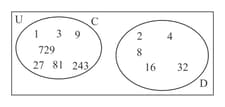Events
Events: Overview
This topic consists of various concepts like Events in a Random Experiment,Types of Events in Probability,Simple Event, etc.
Important Questions on Events
Find the probability that a number selected at random from the numbers will be their mean.
A word consists of 10 different alphabets, in which there are 4 consonants and 6 vowels. Four alphabets are chosen at random. What is the probability that more than one vowel is selected?
A town has two doctors x and y operating independently.if the probability that the doctor x is available is 0.9 and that for y is 0.8,then find out the probability that at least one doctor is available when needed.
A coin is tossed three times, consider the following events.
: 'No head appears', : 'Exactly one head appears' and : 'Atleast two heads appear'.
Do they form a set of mutually exclusive and exhaustive events?
Two dice are thrown and the sum of the numbers which come up on the dice is noted. Let us consider the following events associated with this experiment
: 'the sum is even'.
: 'the sum is a multiple of '.
: 'the sum is less than '.
: 'the sum is greater than '.
Which pairs of these events are mutually exclusive?
A simple event for a random experiment 'rolling die'
In an unbiased coin is tossed then the event of getting head and getting tail are
Which of the following experiments does not have equally likely outcomes?
Two dice are thrown together. Describe the following events associated with this random experiment.
Sum of the numbers on the top of dices is .
Sum of the numbers on the top of dices is .
Sum of the numbers on the top of dices is .
Which events are compound events?
A coin is tossed, and a dice is rolled simultaneously. Determine the total number of elementary events associated to this experiment.
A fair, six-sided die is rolled once. If is the event of rolling a and is the event of rolling a factor of , then find
A fair, six-sided die is rolled once. If is the event of rolling a and is the event of rolling a , then find
A fair dodecahedral die numbered and is thrown and the number noted.
The events , "thrown an odd number", and , "throw an event number ", are represented on the venn diagram below:

State with a reason whether events and are mutually exclusive .
For the given pair of events, state whether they are mutually exclusive, independent or neither.
it will rain tomorrow
it is raining today
For the given pair of events, state whether they are mutually exclusive, independent or neither.
throw a head on a fair coin
throw a pair number on a fair die numbered
